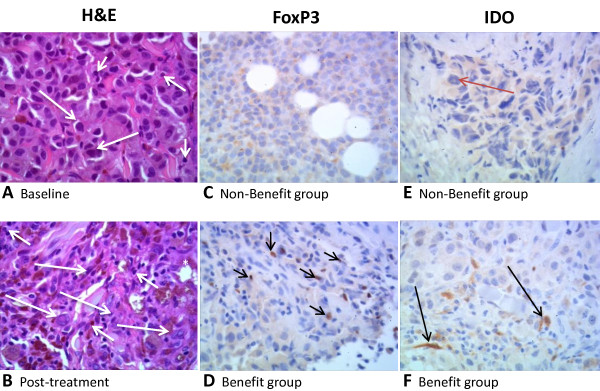Figure 3.
Tumor tissue samples from patients with malignant melanoma treated with ipilimumab. 60× images of skin (A, B, F, Subject 04055; E, Subject 04024) and soft tissue (C, Subject 04066; D, Subject 04002) involved with metastasis and infiltration of melanoma cells, respectively. (A-B) Skin under the epidermis stained with hematoxylin and eosin (H&E) before (A) and after (B) treatment with ipilimumab. Melanoma cells are characterized by abundant cytoplasm, large and central nuclei, apparent nucleolus (large arrows). In contrast, melanin pigment (star) is associated with mononuclear leukocytes (small arrows). Note the increase in tumor-infiltrating mononuclear leukocytes (TILs) post-treatment (B) relative to the baseline (A) in this clinical benefit subject. (C-D) FoxP3 positive staining (with anti-FOXP3) of the nuclei of mononuclear leukocytes (small arrows) in a clinical benefit subject at baseline (D). Non-clinical benefit subject (C) shows no staining of mononuclear leukocytes at baseline. (E-F) IDO expression (anti-IDO staining) at baseline in a clinical benefit subject (F) shows staining of mononuclear leukocytes (small arrows), and spindloid and endothelial cells (large arrows). IDO expression is minimal in the non-clinical benefit subject (E) at baseline, showing focal and weak staining of melanoma cells (red arrow). H&E scores for tumor-associated infiltrating mononuclear leukocytes: (A) ≤ 50%, (B) > 50%. Staining scores for FoxP3: (C) 0, (D) 1. Staining scores for IDO: (E) 0, (F) 1.

